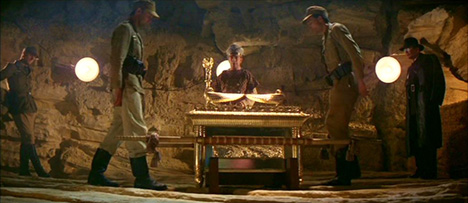“It belongs in a museum!”

So often the book of Revelation is treated like a prize in an Indiana Jones story…
Steven Opp’s review of “Moses and the Revelation.”
“It belongs in a museum!”
This is what Indiana Jones always tells the villain who is attempting to steal the priceless artifact.
I remember as a kid watching these movies and finding myself sometimes sympathizing with the bandits. If I had worked hard to unearth a valuable relic, I’d want to keep it for myself too, either as a trophy or to sell and get rich. I thought noble-minded Indy was being a stick in the mud.
But if you watch the films through to the end, you find that the stick in the mud always turns into the only ladder to heaven, faithfully walking in fear of the supernatural power of the living God while serving as a priestly mediator in order to cover the ones he loves, the real treasures.
So often the book of Revelation is treated like a prize in an Indiana Jones story. It is either left buried in the ground because it is too hard to understand, or it is made into an idol and like a Nazi power grab used to build a fantasy world, treated as a generator of grandiose theories or as a magical conduit of secret knowledge. Moses and the Revelation is Mike Bull’s way of bravely snatching the jewel back and telling us in no uncertain terms, It belongs in a museum!
By returning the book to its home with the rest of the Bible, Bull prevents us from making too much or too little of it as he dusts off its glitter while reconnecting it to its golden roots. In its proper place as the finale of a singular story with every line an echo or spin-off of something said elsewhere in the Word, Bull helps us see that while Revelation is fascinating, it is not an enigma. Its truest value is not in its “standing out” but in its “fitting in.” Bull shows us that the glory of Revelation, what makes it authentically heavy, is that it is deeply connected to the other texts and to first century history. This makes it much more difficult to run away with and use to fashion renegade doctrines.
Moses and the Revelation accomplishes two things. First, it takes the polish off of a lot of the exciting interpretations of Revelation you may be familiar with. It is much less interested in the headline news and much more interested in the Pentateuch. Like reluctant Indy in The Last Crusade chasing after his father’s dream, you are forced to go on the quest with the one you are all too familiar with, none other than Moses. And Moses has always seemed to take the fun out of things, what with all his bizarre interest in how to chop up animals or arrange furniture in the tabernacle.
But if you hang in there and give the old lawgiver a listen, you will find that Revelation is deeper and richer than you ever imagined. You will discover, like John did, that the words are not just meant to be read and interpreted, but are to be eaten. When you partake of Revelation in connection to the rest of the Bible the way that Bully serves it up, your mind will be molded by the ancient structures and symbols, and you yourself will become the thing of value because you are walking in step with the cadences of Christ. And thereafter whenever conversations arise among friends about what is going on in the last book of the Bible, you may be chided as the stick in the mud who wants to return the thing to the Gospels, to the Prophets, to the Torah.
But you’ll find that at the end of the day you will be the one with his feet firmly on the ground, standing fast when the catastrophes of bad exegesis crumble around you.
You can read the introduction to Moses and the Revelation here. You can purchase the book in paperback or for Kindle here.

























